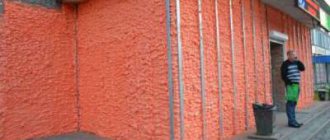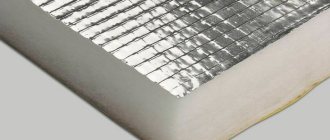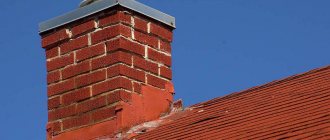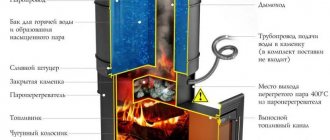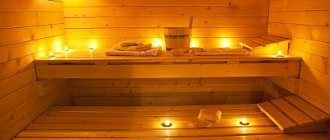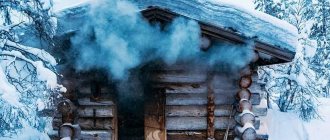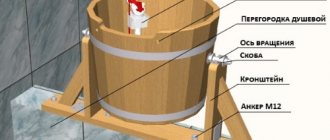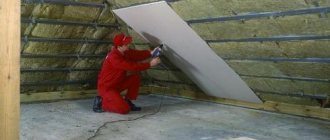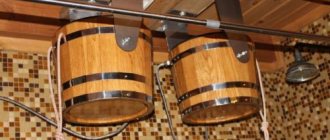I was faced with the task of insulating an extension to a house that was built from expanded clay concrete blocks. I considered 3 options for insulation: penoplex, mineral wool and sprayed polyurethane foam insulation Polynor.
The total area of the three walls is about 40 sq. m. For insulation with penoplex, I would have to additionally buy adhesive foam and umbrellas on which the insulation sheets are attached. Then drill, apply glue, fix, hammer in umbrellas, foam the joints. This is not so fast, but I would like to insulate the walls in a minimum of time, since it was already getting quite cold.
To insulate with mineral wool, again it was necessary to drill under the umbrellas, install the mineral wool and cover it on top with a wind barrier. It’s not the fastest activity and it’s not the cheapest either.
As a result of deliberation, I decided to purchase Polinor spray insulation in cylinders and apply it to the entire surface of the walls. I read the reviews - they write differently everywhere. But still I decided to try it, and the price is a little more expensive than penoplex, but it takes a lot faster.
Installation features
There are special requirements for preparing the surface for applying insulation.
First you need to clean it of debris, and then start removing grease stains. If this is not done, adhesion between surfaces will be significantly reduced. Work should be planned during the warm season. The recommended temperature regime for creating a heat-protective layer is within 17-20 degrees. Appropriate air temperature and low humidity levels will ensure uniform distribution of the composition throughout the work area. You need to start insulating by studying the instructions and installing the nozzle on the cylinder. It is fixed until there is a characteristic click. Next, the cover is removed from the cross and the gun is screwed on. The nozzle is included with the heat insulator, but the gun will have to be purchased separately. The procedure for preparing the cylinder for use is performed in a vertical position. Before spraying one-component polyurethane foam, shake the container thoroughly.
The product must be distributed sequentially, forming a monolithic layer. The maximum thickness of the insulation should not exceed 5 cm. Upon completion of work, the gun is cleaned with a special solvent or mechanically.
Advantages and disadvantages
Before you start insulating your home, you need to weigh the pros and cons. Of course, many are interested in what benefits will come from this method of insulation. These include:
- fast speed of insulation, even if a large surface is processed;
- foam is not subject to biological influences, mold or mildew is unlikely to appear on the wall;
- low-flammability material: it can only melt at temperatures above 80 degrees;
- there is no need to first attach the frame to the facade - this saves effort, time, and money;
- a monolithic surface is obtained without seams into which cold air could penetrate;
- When insulating pipes or other metal elements, a sufficiently dense layer is created, through which moisture will not seep through and corrosion will not appear.
But, like any other insulation method, it has its drawbacks. You should know about them in a timely manner:
- should not be exposed to direct rays;
- inability to interact frequently with water;
- cost of material: to insulate large areas you will need to buy or rent special equipment;
- insufficient level of vapor permeability, artificial ventilation will have to be installed inside;
- You cannot perform the application procedure without a tarpaulin suit, a respiratory mask with goggles and gloves. Of course, all this is unlikely to be found at home, and this is also an extra waste of money.
People have long begun to insulate their homes with foam, but the ideal means of insulation has not yet been invented.
Of course, the effectiveness of this method cannot be disputed. The main thing is to buy high quality materials. If you have equipment for installation, the process will not take much physical effort and time. After applying the foam composition and after it has completely dried, craftsmen advise treating the surface of the facade with a special coating, which can be purchased at any hardware store. This is required first of all to protect human health, and only then - to protect the insulation itself.
DIY application technology
Applying liquid insulation does not require any professional skills or expensive equipment (with the exception of liquid foam). To work, you will need a roller (brush or spray). When using a roller, you will also need a container to evenly rub the mixture over its surface. The process itself includes the following steps:
- We prepare the surface (clean the walls from excess mortar, sweep with a brush and wash with water).
- We prepare the material (if necessary, dilute it to the desired consistency).
- Pour paint into the roller container.
- Dip the roller in paint and roll it out on a special area until the mixture evenly saturates the roller.
- We carefully apply the insulation to the wall, no need to press hard. The first layer is applied from bottom to top.
- Subsequent layers are applied after complete polymerization of the first, usually after 24 hours (to find out the exact values, see the instructions for the insulation).
When drying any of the layers, it is necessary to avoid getting them wet, since most liquid thermal insulators are water soluble. Because of this, the impact of water on insulation that has not completely hardened can cause its complete or partial removal from the surface.
Application technology - video instructions:
Consumption per 1 m2
As noted in the advantages, this insulation is quite economical. The consumption of polyurethane foam in cylinders is as follows: 1 liter is enough to cover a wall of 1 m2 with a layer 4 cm thick. For comparison, when working with mineral wool, you will need to spend more. In addition to the material, additional elements are needed for insulation, that is, sheathing, fasteners, etc., which also costs money.
Required layer thickness
It all depends on the region in which the object is located. For clarity, there is a table that indicates how thick the layer should be for a specific element.
Polyurethane foam
The initial raw material for the production of such foam is a urethane polymer, which foams through chemical reactions and increases in size by almost 50 times.
In its structure, it is almost like polyurethane foam, with the difference that it has a finer structure.
Foaming of polyurethane foam (PPU) in a special device (production unit) is carried out in just a few minutes, after which it is supplied to the desired surface.
Final hardening lasts for 24 hours, then the façade walls can be sheathed with the necessary material.
Using polyurethane foam you can insulate:
- walls of houses (mostly frame);
- attics, roofs;
- house facades;
- basements, lower floors, etc.
The thermal insulation layer ranges from 4-8 centimeters with a high degree of efficiency.
Among the advantages of polyurethane foam, it is worth especially noting the high degree of hardening and adhesion to other materials.
PPU insulates surfaces made of various materials: foam concrete, brick, cinder blocks and gas silicate blocks.
Polyurethane foam is one of the lightest insulation materials by weight, which is why it is also widely used for insulating old houses.
If you need to insulate a small area, it makes sense to purchase foam in a balloon, which is enough for a layer three to four cm thick for an area of approximately 1 sq/m. To calculate the cost and amount of foam, you need to proceed from the area of the surface being treated.
Read an informative article about roof insulation with polyurethane here.
Receiving PPU
When mixed, polyol and isocyanate produce foam, which increases in volume and then hardens. During the manufacturing process, it is necessary to adhere to a number of requirements: maintain the required temperature and mix all components well, which makes it possible to obtain a polyurethane output that does not have seals and large air cavities.
If you change the production method, you get polyurethane foams that differ in their basic characteristics. Some are better suited for insulating openings for doors and windows, others for brick and panel buildings or pipelines. By changing the proportions of the ingredients, when mixing them, polyurethane foam with different cell sizes is obtained.
The most popular materials in this group are the following:
- Foam rubber. It is widely used in everyday life and is familiar to every person. It is used as an upholstery filler for upholstered furniture and lining material.
- Rigid polyurethane foam is used when performing installation work. It has been noticed that this insulation is negatively affected by acids and solvents.
Application area
The scope of application of the sprayed material is quite wide:
- First of all, this is industrial construction. Insulation of industrial buildings is a rather long and labor-intensive process. The use of such insulation makes it possible to significantly reduce the construction period, and therefore its cost.
- Insulation of heating mains. All large main pipelines are buried in the ground. This means that the insulation does not have any problems with ultraviolet rays. And the use of material for installing pipes during repairs significantly reduces the period of localization and elimination of an accident on the heating main.
- Low-rise construction.
Due to its price, insulation is most widely used in low-rise construction. Only owners of private houses can afford to purchase and use this type of insulation. The main reason for the popularity of this method is the acceleration of work on insulating the perimeter of the building and the ability to use one material for any surface.
Consumer properties
Like any insulating material, Polynor has a number of advantages:
- Features excellent heat conservation. These insulation indicators are higher compared to expanded polystyrene and mineral wool.
- Non-toxic. Consumer reviews about Polinor are quite good, since it is not poisonous and does not require protective equipment when using it.
- Ease of use. When using POLYNOR, a heat-insulating layer is created, which does not require a frame for fastening. Also, no tools or auxiliary materials are required.
- Excellent grip. The composition quickly adheres to any surface - brick, wood, plastic, stone, concrete, which significantly expands the scope of its application.
Polynor insulation is very popular due to the fact that it is applied by spraying. This affects better adhesion of different surfaces, even if they are not very smooth. Very often this insulation is used to finish hard-to-reach places, for example, where pipes or cables are laid.
Precautionary measures
Despite the safety of the Polinor composition, it is recommended to observe the following precautions when performing insulation measures. • When the composition is released from the cylinder, there is an increased concentration of the chemical components of the insulator, which can cause irritation to the mucous membranes of the eyes, respiratory system, and skin
Therefore, work should be carried out in special clothing, safety glasses, a mask or a respirator.
• When the composition is released from the cylinder, there is an increased concentration of the chemical components of the insulator, which can cause irritation of the mucous membranes of the eyes, respiratory organs, and skin. Therefore, work should be carried out in special clothing, safety glasses, a mask or a respirator.
• Do not spray the contents of the cylinder near an open flame. The presence of gas may cause a fire. It is also prohibited to combine installation with smoking cigarettes.
• In the room where thermal protection is installed, you need to open windows and doors to organize good air ventilation.
In general, working with polyurethane foam insulator Polinor, produced in cylinders, is characterized by simplicity and uncomplicated application techniques, which is confirmed by user reviews.
Major manufacturers of liquid insulation for buildings (structures) or utility networks
Today, a very large number of manufacturers have begun to produce ultra-thin liquid thermal insulation. However, many of them sell ordinary paint as liquid insulation. How to make the right choice? Let's look at this issue together and present a rating of the most popular manufacturers of this thermal insulation material.
Liquid thermal insulation Astratek
This material is produced by Russian. All products of the concern have appropriate quality certificates and a positive conclusion from the fire service and sanitary and epidemiological station. Liquid insulation Asstratek easily has the consistency of mastic and is easily applied with your own hands to any surface using a roller, sprayer or brush.
- It is not destroyed when exposed to precipitation because it has hydrophobic properties.
- There are no “cold bridges” unlike traditional insulation.
- Non-toxic and meets environmental standards.
- Does not support combustion, and is completely safe from fire safety.
- Completely preserves the architecture of the facade and does not steal useful space.
Liquid insulation RE-THERM
The insulation of this class consists of silicone and ceramic microspheres, which are located among a binder based on acrylic and latex. Thanks to this structure, this material has excellent waterproofing properties and, at the same time, high elasticity and particular strength.
The manufacturers of this product promise that the thermal conductivity of 1 mm of RE-THERM liquid insulation corresponds to 5 cm of mineral wool.
- This liquid insulation can be used on various surfaces, from concrete and brick to glass and plastic.
- Demonstrates ideal characteristics in the temperature range from −470 to 250 C.
- Quick drying, which ranges from 3 to 24 hours.
- High resistance to various mechanical influences, as well as to ultraviolet and infrared rays.
- Can be used both outside and inside buildings and structures.
VIOTERM Metal ALLUMA
This type of coating is specially designed for processing metal structures and engineering structures. Thanks to its structure, liquid insulation VIOTERM Metal ALLUMA gives the surface a glossy tint and reliably protects the surface from corrosion.
In addition to the above advantages, this ALLUMA coating perfectly retains heat in hot water supply and heating systems.
- It is used exclusively for treating metal surfaces as waterproofing.
- Demonstrates effectiveness at ambient temperatures from −50 C to 250 C.
- Low consumption, which is only 1 liter per 1 m2 with a layer thickness of 1 mm.
- When insulating water supply systems for hot water supply and heating systems, heat losses are reduced by 30%.
- The service life of this coating is 10-15 years.
Liquid foam
This type of insulation includes almost all foam materials based on polymer resins. The quality of the final product, including its environmental friendliness, largely depends on them. There are raw materials whose use is not permissible for residential premises due to the high toxicity of the polymer and its long-term emissions. At the same time, such materials are quite suitable for insulating technical structures or isolated building elements (if there is confidence in their insulation and the conscientiousness of the working specialists).
At the moment, such types of liquid foam as polyurethane foam, penoizol, as well as a number of products in compact cylinders are common.
Polyurethane foam (PPU)
Viscous heterochain polymers in a liquid state are used as the main component of this insulation. During chemical reactions, urethanes foam, which leads to their increase in volume by more than 50 times.
In its frozen state, polyurethane foam resembles ordinary polyurethane foam, the main difference in the structure is less porosity.
Mainly used for:
- Insulation of walls of frame buildings;
- Roofing structures;
- House facades;
- Thermal insulation of basements and lower floors.
To apply polyurethane foam, you need a special unit that first mixes and foams the insulation components, and then delivers the finished mixture under pressure to the surface to be treated. Final polymerization occurs within 24 hours, after which the finishing can be installed. Polyurethane foam is suitable for treating surfaces made of brick, concrete, wood, metal, cinder blocks and gas silicate blocks.
The average cost of work including material is 1000-1500 rubles per m2, with a layer thickness of 50 mm.
Penoizol
A budget analogue of polyurethane foam insulation, since it is based on relatively cheap, but more toxic urea-formaldehyde resin. The structure of this insulation is very similar to ordinary foam plastic, but its use is more preferable due to the absence of cold gaps in the insulating layer, characteristic of sheet and roll materials.
The density of penoizol, even in a liquid state, is noticeably lower than its urethane analogues, which does not allow its use in loaded structures. Otherwise, the scope of application is similar to polyurethane foam. Thermal insulation qualities are also not exceptional and are comparable to mineral wool, and two times less than that of the polyurethane foam described above.
Apply under pressure after pre-mixing the components and foaming. Increases in volume by no more than 30 times relative to the original mixture.
Roof insulation with foam insulation
Work together with the material costs approximately 2000 rubles per 1 cubic meter.
"Polinor"
This is a liquid insulation based on polyurethanes. A common form of release is small cylinders, similar in appearance to those for polyurethane foam. Using one cylinder you can insulate about 1 m2 of surface with a layer thickness of 6-7 cm.
The strength and thermal insulation qualities are similar to polyurethane foam, but unlike it, “Polinor” is more suitable for household use, since it does not require special equipment for application. The relatively high cost (about 500 rubles per cylinder) makes its use inappropriate over large areas.
The insulation is applied by spraying, which allows it to be used on almost any surface, for example, for thermal insulation of pipelines located outdoors.
As for filling voids in the walls, this procedure cannot be completed due to insufficient pressure in the cylinder.
"Polinor" has the following technical characteristics:
- Thermal conductivity – 0.025 W/(m*K);
- Moisture absorption coefficient – no more than 0.03;
- No toxicity, non-flammable;
- Solid density – not less than 28 kg per m3;
- Retains all operational properties for 50 years;
- The operating temperature should not exceed +121°C;
In addition, the mixture is quite chemically stable and does not interact with most reagents common in everyday life. Chloroform, dichloroethane, and high concentration hydrochloric acid have a negative effect (promote swelling) on Polinor. Nitric and sulfuric acids react with polyurethane, thus destroying the insulating mixture as a whole.
Current prices for your city:
Material characteristics
Polyurethane foam (PPU) looks like a homogeneous structure of foam material, consisting of air bubbles filled with gas. Various versions of polyurethane foam are deservedly popular because they can be manufactured directly on the construction site. The most common method is to apply the material to the surface by spraying. Spraying is used for thermal insulation of houses, industrial workshops, pipelines, and in addition, it is actively used in the interior of premises.
Filling is used when it is necessary to fill a cavity between walls or a gap between installed finishing layers.
The thermal conductivity coefficient of the material is 0.023-0.025 W/mS. Teplis heat insulator is lightweight and can be easily applied to surfaces made of any materials (concrete, brick, glass, wood, aluminum, PVC).
Thanks to the optimal ratio of open and closed cells in the structure, the insulation “breathes”. Accordingly, the treated surface always remains clean and dry.
Other product benefits include:
- resistance to temperature changes;
- environmental friendliness;
- duration of operation (at least 20 years);
- seamless application, eliminating the formation of cold bridges;
- good sound insulation;
- low flammability;
- immunity from harmful rodents and insects.
Teplis polyurethane insulation is sold in 1 liter cylinders. Included with this product, the manufacturer offers to purchase a mounting gun with nozzles for uniform spraying.
Basement of a house with sprayed insulation applied
Peculiarities
In order to insulate the walls in any home, it is best to use polyurethane foam. This type of foam hardens very quickly, which allows you to get a dense surface in a matter of hours that separates the interior of the room from external temperature changes, drafts and moisture penetration.
The main characteristics of foam include:
- heat resistance - the material can withstand heating up to eighty degrees;
- capable of letting water through if necessary;
- possibility of providing vapor barrier;
- high level of strength;
- increases in volume after application.
When using this material, you don’t have to worry that the wall structure can easily ignite, because the foam resists this in every possible way. With all the positive aspects of this material, there is also one negative aspect. It concerns the ability to freeze. If you foam something in a closed space, it will not freeze. In addition, the high cost of this product does not allow everyone to use foam to insulate walls in the house.
With constant contact with the aquatic environment, this material begins to deteriorate and eventually becomes completely unusable. Application of foam requires good ventilation, which means that certain conditions must be created for work
This material has low vapor permeability, so it is important to provide forced ventilation in the room
When applying foam with a thickness of four or more centimeters per square meter, you will need to use one balloon
In order to be able to do the work correctly and without risk to health, it is important to work using a pneumatic gun. This is special equipment that helps to spray foam evenly over a specific surface.
Such a gun mixes foam with gas and delivers it to the surface, evenly spraying where it is needed. Using such a device, you can independently adjust the intensity of the foam supply for more comfortable work. It is very convenient to use a pneumatic gun, but not everyone resorts to it due to the high cost of such equipment.
When applied to the surface, the foam does not form any seams, which is convenient and aesthetically pleasing. This material has minimal thermal conductivity. An important indicator is its environmental friendliness - when used, no harmful substances are released into the air. Any impact on the foam will be painless for it; it only reacts poorly to ultraviolet radiation.
When insulating a room, it is advisable to take care of sound insulation, which foam also does well. In addition, it has good adhesion to the surface. The foam is easily applied to uneven surfaces, while the formation of air pockets is completely eliminated. Rapid hardening allows you to continue working within 24 hours. Foam for wall insulation is a universal and convenient option, with the help of which even a non-professional can do everything well and efficiently, most importantly, follow safety precautions.
Expert opinion on foundation thermal insulation options
For the most part, builders agree that it is best to insulate the foundation from the outside. In order not to be unfounded, they give quite compelling arguments in favor of this method.
Regardless of the type of insulation used and the type of foundation, external thermal insulation allows you to protect the foundation from freezing, preventing the penetration of low temperatures into the structure. External insulation has a positive effect on both the quality of concrete and the structure of the foundation, preserving their strength for many years. Also, the external insulation is an additional barrier to groundwater, helping the waterproofing to protect the foundation from moisture. In addition to the lower part of the foundation, external insulation resists temperature changes that occur in the upper, basement part of the house when the seasons change.
But there are cases when insulating the foundation from the outside is impossible, then, of course, the owner does not face any dilemma and there is only one thing left - to insulate it from the inside. In fact, there are not so many advantages, but to be honest, there are only three:
Insulating the foundation from the inside has a positive effect on the microclimate of the basement and the entire house in general. Internal thermal insulation protects the foundation from groundwater. Internal insulation prevents condensation from accumulating in the basement.
In principle, there are positive aspects, but there are also negative ones:
Still, the foundation freezes outside. Due to temperature changes and soil heaving, deformations of the foundation occur and cracks appear along its entire perimeter.
What good is it if the foundation you built so carefully begins to crumble and collapse in a few years?
Which variety to choose
In many ways, the choice will depend on the specific situation and what area needs to be treated. Using an example, we can consider the most common cases when a house needs foam insulation:
- If you need to seal cracks or eliminate any other defects on the surface, then polyurethane is suitable. But such material should not be exposed to sunlight.
- If you need to fill a large volume, then penoizol is suitable. But an ordinary cylinder will not be enough; you will need to purchase a special device with high pressure. You don’t have to buy it at all - you can rent it or borrow it from friends, because no one will use it often.
- If you need to seal small cracks and carry out thermal insulation in small areas, you can buy a cylinder with regular polyurethane foam. It does not support combustion, after hardening it is particularly hard, and it has an ecological composition.
- If defects are found on the outside of the wall, then you need to apply a composition based on polyurethane. It is applied directly using a special cylinder or apparatus.
It is worth remembering that foam insulation creates errors inside the layer that need to be eliminated.
To do this, you will need a long hose to push the material inside. If it is necessary to fill air gaps inside the insulation, then holes are made in the wall with something sharp. Polyurethane foam is not suitable for insulating the entire external facade - it does not have the appropriate characteristics necessary for this. Therefore, you should not choose it for these purposes, even despite its more economical cost.
Points of sale
You can buy our products at your nearest point of sale.
Your privacy is very important to us. We want your experience on the Internet to be as enjoyable and rewarding as possible, and for you to feel comfortable using the wide range of information, tools and opportunities that the Internet offers. Personal information collected when ordering services (or in another form) on the site is used to prepare services in accordance with your needs. Your information will not be shared or sold to third parties.
What data is collected on the site?
When voluntarily submitting data using forms, you submit your name, e-mail or phone number.
For what purpose is this data collected?
The name is used to address you personally, and your e-mail or phone number is used to conduct a dialogue with you about the possibility of providing our services. At the same time, we do not send SMS or e-mail messages; all offers and promotions are advertised only on the website. Your name, e-mail or phone number are not transferred to third parties under any circumstances, except in cases related to compliance with legal requirements. However, while we strive to keep your personal information secure, you must also take steps to protect it. We strongly recommend that you take all possible precautions while surfing the Internet. The services and websites we operate include measures to protect against the leakage, unauthorized use and alteration of information under our control. While we make every effort to ensure the integrity and security of our network and systems, we cannot guarantee that our security measures will prevent third party hackers from unlawfully accessing this information.
To contact the site administrator with any questions, you can write a letter to the e-mail specified in the “Contacts” section.
Is it possible to insulate a house with foam yourself?
Most often, they carry out work related to the internal insulation of the house with their own hands. For this you will need:
- Wood slats or metal profiles as guides for sheathing.
- Construction gun and balloon foam.
- Knife with a sharp blade.
The surface to be treated must first be cleaned of dust, cobwebs, mold and other contaminants. Then you can begin fixing the sheathing profiles. The gaps between them should be 50 centimeters. They are mounted vertically on the wall, additionally fastened with horizontal jumpers at the same distance. If there is furniture left in the room, it is recommended to cover it with film. The eyes are protected with goggles, the body and hands are protected with a suit and gloves, respectively. The further procedure looks like this:
- It is recommended to treat the construction gun with automotive lubricant.
- The can is inserted into the gun, and you can begin treating the surface with foam.
Installation of metal or wooden beams
Before installing the sheathing, the surface will need to be prepared - remove cobwebs and dust, remnants of the old finishing coating, cement, etc. A deep penetration primer is applied to the cleaned surface with a roller or spray. It will create a thin protective film.
The slats or profiles are fixed in increments of 50 centimeters, installing horizontal jumpers to increase strength also every half meter. Depending on the base material, suitable hardware is selected. These can be anchors or dowels
Before installing the insulation, it is important to provide in advance places for laying electrical cables or other utilities
Spraying foam using a compressor
First of all, the heat insulator is applied to problem areas - with cracks, joints and crevices. In this way, it will be possible to get rid of voids that could become cold bridges in the future. Next, the voids are filled in those places where the sheathing is adjacent to the insulated surface. You need to spray the polymer insulation from side to side, movements should be sweeping and even. They are produced from top to bottom. When treating a metal surface, it is recommended to pre-clean it from rust, as well as treat it with a corrosion-preventing agent.
It is important not to allow the sheathing to be completely covered with the composition.
Drying
The material begins to foam while still inside the compressor. Once applied to the surface, it will harden in approximately 15-20 minutes. It will take at least a day to dry completely, and if the layer is thick, then three days. It is recommended to begin final finishing after five days.
Alignment
Before finishing, the surface must be carefully leveled. It will be enough to cut off the excess frozen foam with a sharp knife. The heat insulator must be flush with the sheathing beams
It is important that the coating is smooth, without bumps or depressions. Sometimes it can be difficult to work with just one knife
Then you can use a hacksaw with a fine tooth. After all manipulations, the finishing material can be fixed to the surface.
Finishing
Foam insulator is not suitable for subsequent plastering, puttying, or wallpapering. Here is a list of suitable facing materials:
- plasterboard sheets;
- panels made of wood, glass or plastic;
- wooden lining;
- OSB or fiberboard sheets.
Why you shouldn’t insulate the foundation from the inside
Most experts argue that internal insulation is far from the best way to change the heat resistance of the base part of the foundation. And this is true, because the effectiveness of this technology is questionable, and the consequences of such a rash decision are obvious.
In addition, such insulation will not shift the dew point into the body of the masonry (or monolith), but will only close it, therefore, the effect of moisture condensation in the contact zone of the warm underground air with the cold wall will not disappear anywhere.
In addition, the internal insulation will reduce the already small volume of the subfloor, which will complicate the inspection of the basement floor, as well as repair work in the interior of the basement area.
We insulate the foundation with our own hands from the inside - when there are no other options
The process of insulating the base from the inside begins with careful preparation of the insulated surface (the inside of the foundation walls).
To do this you need to do the following:
- First, eliminate all defects on the foundation walls (seal cracks, crevices, holes).
- Secondly, apply a layer of frost-resistant waterproofing to the inside of the foundation wall.
- Thirdly, wrap the inner surface of the basement floor with a layer of vapor barrier, permeable only from the side of the house (from top to bottom).
After this, you can begin to select insulation material and thermal insulator installation technology. Moreover, in most cases, either expanded clay, backfill soil, or foam panels are used as an insulator.
Accordingly, soil and expanded clay are simply poured into the sinuses of the foundation - in this case, a possible revision of the subfloor and its repair should be forgotten immediately. But this method is very cheap and this is its main advantage.
However, bulk thermal insulation can only be installed in an open foundation without a basement floor. Installation of panel insulation can be arranged at any time.
And this operation looks like this:
- Foam panels are glued to the inner surface of the base or fixed with thermal dowels.
- The seams between the panels are filled with polyurethane foam.
- A fiberglass reinforcing mesh is stretched over the panels.
- A layer of facade plaster is applied over the mesh, increasing the fire resistance of the finish.
This method is more expensive, but the effectiveness of this technique is comparable to progressive external finishing.
At the end of the process of insulating the base, care should be taken to ventilate the subfloor. To do this, it is necessary to leave vents in the body of the foundation wall - through holes located on the same axis. In the warm season, the vents are opened, and the natural flow of air removes condensation from the underground that has accumulated during the cold season. Well, in winter the vents are carefully sealed, preventing heat leakage from the underground.
Spray insulation PENOPLEX FastFix 850 ml
Sprayed one-component insulation - a universal one-component polyurethane aerosol spray - is used for insulation of building structures, domestic and commercial premises. Insulation can be applied to any surface, including vertical surfaces and surfaces with a negative slope (inner surfaces of roof slopes, etc.). Ideal for small spaces. It can also be used as an auxiliary insulation for application on uneven and geometrically irregular surfaces, as well as where it is technically difficult to use sheet insulation. Heat resistance (of fully cured adhesive foam) during long-term use: from -45°С to +90°С Area of one cover layer during continuous application (depending on the nature of application), m²: Up to 2.2
PROPERTIES:
- for external and internal work;
- due to its finer-cell structure, it has lower thermal conductivity than polyurethane foam and better insulating properties
- output volume after lifting the cap – up to 55 liters;
- the rise of one layer is up to 2.5 cm. It is recommended to apply in several layers. Apply the second layer only after the first has cured.
- temperature range of use – from -0 to +30 °C (at a cylinder temperature from +10 to +35 °C);
- operating temperature range – from -45 to +90 °C;
- complete curing time – 12 hours;
- after polymerization – chemically neutral, does not emit toxic compounds;
- resistant to mold and fungi;
- excellent adhesion to all surfaces, with the exception of fluorine plastic;
- does not contain ozone depleting substances or solvents.
SCOPE OF APPLICATION:
- insulation of walls, ceilings, roofs, basements, doors, building structures, etc. in premises for economic and domestic purposes;
- as an auxiliary insulation when using insulation from polystyrene foam, basalt, etc.
- ideal for insulating geometrically irregular surfaces;
- sealing gaps between thermal insulation elements;
- spraying on sheet materials to reduce vibrations and for sound insulation.
- can be used for comprehensive insulation of cracks, holes, joints together with mounting foam and mounting adhesive foam
Color: Bright orange.
TECHNICAL CHARACTERISTICS: Density of the finished product after spraying and polymerization, kg/m³ no more than: 16-20
Volume of the finished product after spraying and polymerization, liters: 50-55.
Lifting height of the cap of one layer, mm: Up to 25.
Surface drying time (to touch), min., no more: 15-20.
Curing time, min: About 60.
Complete curing time, hours, no more than: 24.
Time for possible further processing, min., no more: 90.
Thermal conductivity, W/mK: 0.025.
Recommended number of layers when spraying: 1-2.
Fire resistance class (DIN 4102-1): B2.
The best manufacturers of polyurethane foam
The ranking of well-known manufacturers of polyurethane foam is headed by brands that have earned recognition in the construction industry.
Soudal
The brand has factories in Poland, Belgium and Slovenia. Soudal brand products provide a structure that meets high European standards and a good yield volume. The sealant does not darken or deform over time, and the durability of the product is impressive.
Krimelte
The manufacturer from Estonia (Penosil brand) offers a variety of models of polyurethane foam for various purposes. Krimelte products are known in the professional environment for their decent price-quality ratio.
Titan
The Orion brand, with production facilities in Turkey, Spain and Poland, ranks third in the popularity rating among polyurethane foam suppliers. Products of this brand foam well without secondary expansion.
Ultima
The brand produces good quality polyurethane foam, the products are easy to use. Judging by consumer reviews, the sealant of this brand does not have an acceptable level of efficiency.
Foam for wall insulation
Axton
The company produces a sealant with high odorless polymerization characteristics, while reviews indicate low adhesion and high porosity of the structure.
Titan02
The highly popular mounting foam Titan02 is available in a winter version and with increased fire resistance. The product demonstrates exceptionally high efficiency when installing window and door structures. It is actively used in the repair of utility systems, sealing and thermal insulation of buildings. Titan02 sealant is sold within 230 rubles.
Penosil
The product is distinguished by its density and uniformity of structure with a large output volume. It is used for installation of structures, filling seams and cavities of varying complexity. The model range also includes special versions for foam plastic. The cost varies from 220 rub.
Soudal
Soudal polyurethane foam is available in three types - winter, summer and fire-resistant. The composition has a high density and a minimal level of porosity, and there is no pungent odor. This brand of sealant dries quickly and evenly. The products are especially appreciated by window installation professionals. Prices start from 350 rub.
